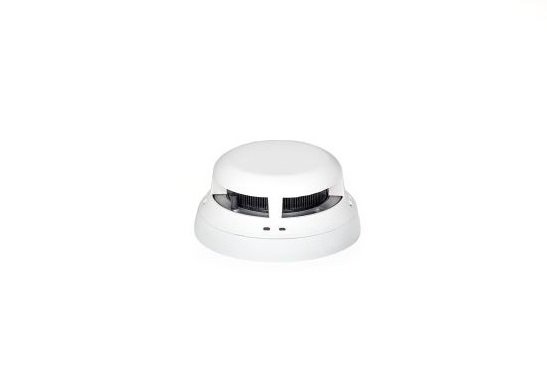Product description (expand/collapse)
The OSD63 multisensor (optical and temperature) detector works in the detection lines of fire and burglar alarm control panels. It is designed to detect temperature changes in the air caused by fire and to detect smoke, which is a product of combustion or glowing of typical materials that make up construction elements or interior furnishings. The OSD63 detector is adapted to work in closed rooms, in which smoke and dust do not occur under normal conditions.
The principle of operation (expand/collapse)
The electronic system of the detector ensures proper functioning of the measurement and logic system in a wide range of voltages in the detection line (from 12V to 28V) without changing the measurement parameters. The smoke density measurement process consists in detecting the light reflected from the smoke particles, which enters the measuring chamber through the slots in the basket and openings in a special optical labyrinth, which also prevents light and insects from getting inside. Such construction of the measuring chamber is intended to make the OSD63 detector immune to external light, insects and accidental irrelevant streaks of smoke, e.g. cigarette smoke.
The detector’s logic will not put the detector into alarm if the smoke threshold is exceeded only once. Disabling the detector from the alarm state is possible after completely blowing the detector and lowering the power supply below 1V for a minimum of 1sec. Selection of the measuring beam wavelength, beam geometry and the angle between the axes of the optical elements determine the particular suitability of the detector for detecting large-sized smoke particles, characteristic of low-energy fires – i.e. smoldering and glowing of materials in the initial phase of fire formation.
Elements for detecting temperature changes in the vicinity of the OSD63 detector (2 detectors) operate in the differential-excessive system – they identify a significant increase in temperature and/or exceeding the temperature limit value. Each detector is individually tested and calibrated to the desired smoke and temperature threshold. The sensitivity of each detector is set in a special smoke chamber while maintaining repeatable conditions of temperature, humidity and smoke.
Construction (expand/collapse)
The detector consists of several plastic elements that can be disassembled without the use of special tools. This is to facilitate possible servicing (vacuuming, washing of elements) in the case of heavily soiled rooms where the autocompensation algorithm has exhausted its adaptability.
An integral part of each detector is the GN63 base. They have been designed with maximum simplification and shortening of the time needed to activate the detector in a given system in mind. Connecting the wires to the socket consists in inserting the insulated terminal into the side hole of the insert (according to the description on the socket). The connection takes place without the use of tools (e.g. screwdriver) and can be done with one hand. The socket has two mounting holes spaced 65÷75mm.
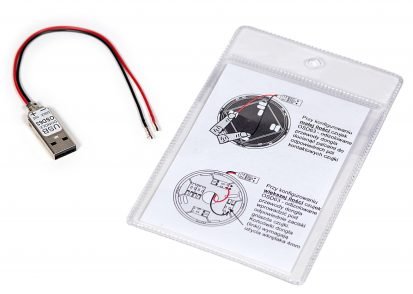
USB dongle OSD63
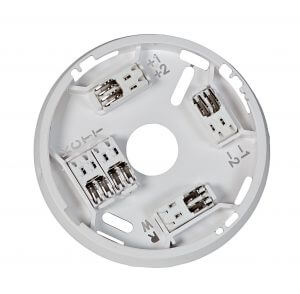
OSD63 base
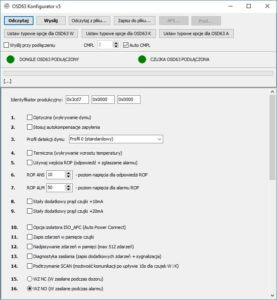
Configuration program
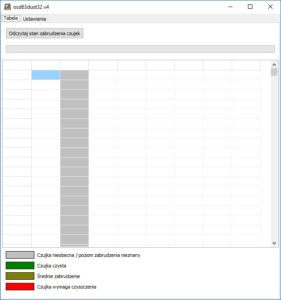
Dirt reading
Device capabilities (expand/collapse)
Thanks to the use of an advanced, energy-saving microcontroller in the OSD63 detector, it was possible to equip it with an extensive detection and control algorithm. This allows the following functionalities to be implemented in the OSD63 detector:
- Enable/disable optical detectors (heat detector)
- Enable/disable thermal detectors (optical detector)
- Enable/disable the dirt autocompensation algorithm
- Selection of the operating mode of the external operation indicator (NC/NO)
- Permanent additional current consumption (+10mA, +20mA)
- Possibility of operating an external conventional call point button (manual call point) with a separate AFS52 address and selection of response and alarm thresholds
- Select the alarm mode
- snap
- erasable
- conjunction
- AR mode (auto reset 1s/6s)
- Support built-in relay (NC/NO mode selection)
- Additional alarm currents (+10mA, +20mA) over standard 20mA
- Address configuration (AFS42, AFS42 ROP, WK address)
- LED signaling options (possibility to enable and disable each option independently)
- surveillance signaling
- contamination indicator
- indication of damage (or critical contamination)
- alarm source differentiation (smoke/heat)
- constant alarm current when the option to distinguish the source of the alarm is selected
- Possibility to read the detector contamination status
- Support of communication through various intermediary devices
- USB dongles OSD63 (5V)
- power dongle USB OSD63 (24V)
- AFS42 control panel and MCU42 module
Technical data (expand/collapse)
| Norm | PN-EN 54-5:2000 + A1:2002, PN-EN 54-7:2000 + A1:2002 + A2:2006 |
| Detector class | A1R |
| Certificate | nr 1438/CPR/0452,CNBOP-PIB |
| Supervision voltage | 20V (12V – 28V) |
| Supervision current | 35 μA |
| alarm current | according to the chart |
| Optical indicators | 2 items red LED |
| Operating temperature range | -25°C to +70°C |
| Static response temperature | +54°C to +65°C |
| Storage temperature range | -30°C to +60°C |
| Relative humidity | 95% at 40°C |
| Spacing of mounting holes | 65 ÷ 75 mm |
| Detector weight | 140g (± 5g) |
| Dimensions | 49/109 mm |


